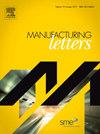Wire arc additive manufacturing of stainless steel/aluminum bi-metal using roll-bonded transition joint
IF 1.9
Q3 ENGINEERING, MANUFACTURING
引用次数: 0
Abstract
Wire arc additive manufacturing was employed to produce an AISI316L stainless steel/AA5183 aluminum bi-metal wall using a bi-layer steel/aluminum transition joint fabricated by roll bonding. The transition joint was utilized to minimize the contact between molten aluminum and steel. The study explored the effect of three heat-input levels used for aluminum deposition on the microstructure and mechanical performance of the steel/aluminum interface in the wall. At the minimum heat-input, no defects or Al-Fe intermetallic compounds were observed at the interface, resulting in the highest bi-metal wall fracture strength (∼42 MPa) due to the absence of brittle intermetallic compounds.
不锈钢/铝双金属滚焊过渡接头电弧增材制造
采用滚焊双层钢/铝过渡接头,采用电弧增材制造工艺制备了AISI316L不锈钢/AA5183铝双金属壁。过渡接头被用来减少铝液和钢液之间的接触。研究了三种不同的铝沉积热输入水平对管壁钢/铝界面微观组织和力学性能的影响。在最小的热输入下,在界面上没有观察到缺陷或Al-Fe金属间化合物,由于没有脆性金属间化合物,导致双金属壁断裂强度最高(~ 42 MPa)。
本文章由计算机程序翻译,如有差异,请以英文原文为准。
求助全文
约1分钟内获得全文
求助全文
来源期刊

Manufacturing Letters
Engineering-Industrial and Manufacturing Engineering
CiteScore
4.20
自引率
5.10%
发文量
192
审稿时长
60 days
 求助内容:
求助内容: 应助结果提醒方式:
应助结果提醒方式:


